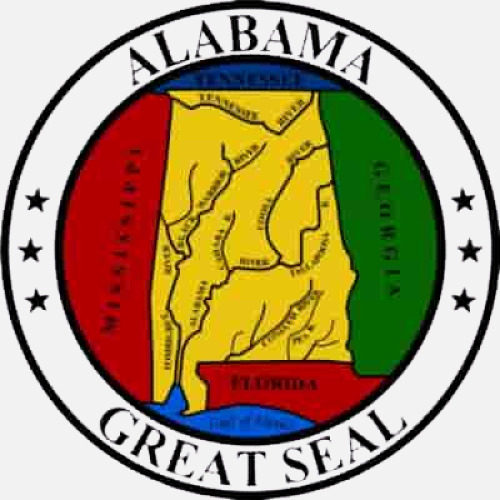 State Flag |  State Seal |
Alabama is a state located in the southeastern region of the United States. It is bordered by Mississippi to the west; Tennessee to the north; Georgia to the east; Florida and the Gulf of Mexico to the south.
- ABBREVIATION: AL
- NICKNAME: Yellowhammer State
- POPULATION: 5,157,699 (2024 est.)
- CAPITAL: Montgomery
- STATE BIRD: Yellowhammer
- STATE FLOWER: Camellia
- AREA: 52,419 sq. mi.
- TIME ZONE: Most of state Central, Phenix and Alabama area Eastern
- ENTERED UNION: Dec. 14, 1819
- ALTITUDE: High, 2,413 ft. Mount Cheaha
- CLIMATE: Humid, with long hot summers, short mild winters. Long growing season, heavy rainfall.
Despite the once fertile “Black Belt” of soil that forms a crescent across its middle, Alabama was one of the first of the southern states to develop industry. As erosion and the boll weevil ruined the cotton crops, Alabamans turned to the rich deposits of coal and iron ore in the rugged northern section of the state. By the end of the 19th century, an industrial center had developed around Birmingham.
Still important in agriculture-its scientifically farmed cotton crops still yield over a billion dollars towards the state’s GDP. In addition, The state has invested in aerospace, education, health care, banking, and various heavy industries, including automobile manufacturing, mineral extraction, steel production and fabrication.
By 2006, crop and animal production in Alabama was valued at $1.5 billion. Today Alabama ranks high as an industrial leader in the south, making steel, textiles, chemicals and transportation equipment.

Downtown Huntsville, Alabama
Alabama is located in the middle of the Bible Belt, a region of numerous Protestant Christians. It has been identified as one of the most religious states in the US, with about 58% of the population attending church regularly.
FUN FACTS:
- Twice as much earth was moved to build the Tennessee-Tombigbee Waterway than during the construction of the Panama Canal.
- In 1955 Alabama became the first state to have a state-owned television station.
- The first rocket that put humans on the moon was built by workers in Alabama.
- Dismals Canyon, a few miles south of Russellville, has natural bridges, waterfalls, and one of the few stands of virgin forest east of the Mississippi River. Aaron Burr used the area as a hideout for several months.
- Alabama in 1861 was the first to design and fly the Confederate Flag.
- George Washington Carver, a freed slave who helped revolutionize the economy of the South through his experiments with peanuts, soybeans, cotton, and sweet potatoes, was the director of agricultural research at the Tuskegee Institute.
History:
Alabama’s history is deeply rooted in Native American heritage, European colonization, the Civil War, and the Civil Rights Movement, making it a state rich in cultural and historical significance.
Long before Europeans arrived, the land was inhabited by Native American tribes such as the Creek, Cherokee, Choctaw, and Chickasaw. These groups developed complex societies, trading networks, and agricultural systems, thriving in the region’s fertile soil and warm climate.
European contact began in the 16th century when Spanish explorer Hernando de Soto traveled through the area in 1540. However, permanent European settlement did not begin until the French founded Mobile in 1702.
Over the next century, Alabama came under French, British, and Spanish control before being acquired by the United States following the American Revolution and subsequent treaties.
Alabama became a U.S. territory in 1817 and gained statehood on December 14, 1819, becoming the 22nd state. The state’s economy quickly grew around cotton plantations, which relied heavily on enslaved African Americans.
This system of slavery defined Alabama’s social and economic structure and created deep divisions that would erupt during the Civil War.
In 1861, Alabama seceded from the Union and joined the Confederacy. Montgomery, the state capital, briefly served as the first capital of the Confederate States of America. Alabama saw several key battles and suffered widespread destruction during the war.
Following the Confederacy’s defeat, Alabama faced the hardships of Reconstruction, during which federal troops occupied the state to enforce new laws and protect the rights of freed slaves. This period also saw the rise of segregation and Jim Crow laws, which disenfranchised African Americans and institutionalized racial inequality.
Despite these challenges, African Americans in Alabama played a central role in the Civil Rights Movement of the mid-20th century. Montgomery was the site of the famous 1955–56 bus boycott sparked by Rosa Parks’ arrest, a pivotal event led by Dr. Martin Luther King Jr.
Birmingham gained national attention in 1963 when peaceful protesters, including children, were met with police violence, shocking the nation and helping to spur civil rights legislation.
The 1965 Selma to Montgomery marches, particularly “Bloody Sunday,” became turning points that led to the passage of the Voting Rights Act.
Throughout the 20th century, Alabama continued to evolve. While agriculture remained important, the state also developed industries such as steel production, automotive manufacturing, and aerospace technology. Huntsville became a center for NASA and the space industry, while cities like Birmingham and Mobile grew into major urban hubs.
Today, Alabama reflects both the struggles and triumphs of its past. It honors its rich cultural legacy through museums, historic sites, and annual events, while continuing to work toward social and economic progress.
From ancient Native civilizations to pivotal moments in American history, Alabama’s story is one of resilience, transformation, and the ongoing quest for equality and opportunity.